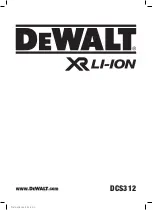
English
3
WArninG:
rEAD AnD UnDErSTAnD ALL WArninGS, CAUTiOnS AnD OPErATinG inSTrUCTiOnS BEFOrE USinG THiS
EQUiPMEnT. Failure to follow all instructions listed below may result in electric shock, fire and/or serious
personal injury.
SAVE THESE INSTRUCTIONS
1. rEAD THE OPErATOr’S MAnUAL BEFOrE OPErATinG THE MACHinE.
To minimize the possible occurrence of accidents
and personal injury, learn the tool’s application, limitations, and specific potential hazards peculiar to this tool.
2. WEAr EYE AnD HEArinG PrOTECTiOn. ALWAYS USE SAFETY GLASSES WiTH SiDE SHiELDS.
unless otherwise
specified, everyday glasses provide only limited impact resistance, they are
nOT
safety glasses. use only certified safety equipment; eye
protection equipment should comply with ANSI Z87.1 standards. Protective hearing equipment should comply with ANSI S3.19 standards.
3. DO nOT USE THiS Or AnY OTHEr MACHinE WHEn YOU ArE TirED, UnDEr THE inFLUEnCE OF DrUGS,
ALCOHOL, Or MEDiCATiOn. WATCH WHAT YOU ArE DOinG, STAY ALErT AnD USE COMMOn SEnSE.
4. WEAr PrOPEr CLOTHinG
. Do not wear loose clothing, gloves, neckties, rings, bracelets, wristwatches or other jewelry that may get
caught in moving parts. Wearing nonskid footwear is recommended as well as wearing protective hair covering to contain long hair.
5. USE AnD KEEP GUArDS in PLACE
and in good working order. Never operate the machine with any guard or cover removed. Check that
all guards are in place, secured, and working correctly before each use to reduce the risk of injury.
6. DO nOT USE THE TOOL in DAnGErOUS EnVirOnMEnTS.
Keep the work area well lighted to prevent tripping or inadvertently
placing arms, hands, or fingers in dangerous positions. Do not use power tools in damp or wet locations or in the rain which can cause shock
or electrocution.
7. KEEP THE WOrK ArEA CLEAn.
Cluttered areas and benches invite accidents.
8. CHECK THE TOOL FOr DAMAGED PArTS
before using the machine. Check for proper alignment of moving parts, binding of moving
parts, component breakage, and any other conditions that may affect the tool’s operation. A guard or any other part that is damaged must be
properly repaired or replaced by an authorized service center to avoid risk of personal injury.
9. rEMOVE ADJUSTinG KEYS AnD WrEnCHES BEFOrE STArTinG THE TOOL.
Keys, wrenches, scrap, and other debris can
be thrown at high speed, possibly causing serious personal injury.
10. KEEP CHiLDrEn AnD ViSiTOrS AWAY.
Your shop is a potentially dangerous environment and visitors should not be allowed to contact
any tools, extension cords, or roam about unsupervised. All visitors should wear safety glasses and be kept a safe distance from the work area.
11. MAKE THE WOrKSHOP CHiLDPrOOF
by using padlocks, master switches, and by removing starter keys from tools.
12. MAinTAin ALL TOOLS AnD MACHinES WiTH CArE.
Keep tools sharp and clean for best and safest performance. Follow
instructions for lubricating and changing accessories.
13. DiSCOnnECT TOOLS WHEn nOT in USE,
before servicing, or when changing attachments, blades, bits, cutters, etc.
14. rEDUCE THE riSK OF UninTEnTiOnAL STArTinG.
Check to be sure that the tool’s switch is in the “OFF” position before plugging
in the power cord. Should a power failure occur, move the switch to the “OFF” position. Accidental start-ups can cause serious personal injury.
15. USE THE COrrECT TOOL FOr THE JOB.
Don’t force the tool or attachment to do a job for which it was not designed. Don’t use the
tool for a purpose not intended as damage to the machine and/or personal injury may result.
16. USE rECOMMEnDED ACCESSOriES.
using accessories and attachments not recommended by the manufacturer or intended for
use on this type tool, may cause damage to the machine or result in personal injury to the user. Consult the operator’s manual for recommended
accessories.
17. MAKE SUrE YOUr EXTEnSiOn COrD iS THE PrOPEr SiZE AnD iS in GOOD COnDiTiOn.
When using an extension
cord, be sure to use one heavy enough to carry the current your product will draw. An undersized cord will cause a drop in line voltage resulting in
loss of power and tool overheating. Consult the extension Cord Chart for the correct size based on the cord length and nameplate ampere rating. If
ever in doubt, use the next heavier wire gauge cord. The smaller the gauge number, the heavier the cord.
18. SECUrE THE WOrK-PiECE.
use clamps or a vise to hold the work-piece when practical. using clamps or similar mechanical device is
safer than using your hands) and allows you to use both hands to operate the tool. Losing control of the work-piece can cause personal injury.




























